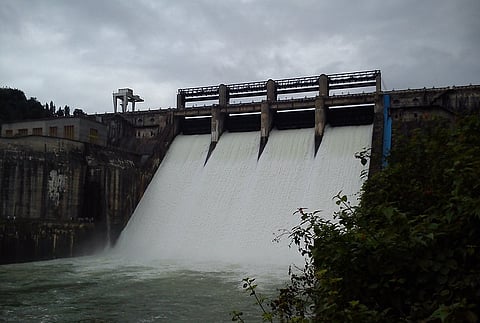

With the delay in the South West monsoon this year, Karnataka may be looking at another year of drought. With reservoir levels dropping, officials with the Karnataka State Natural Disaster Monitoring Centre say that the rainfall may not be enough to sustain both drinking water needs as well as the irrigation demands this year around.
The monsoon, which was slated to set in between May 31 and June 2, has not yet arrived in Karnataka, except for a few bouts of rainfall in the Malnad region. With neighbouring Maharashtra receiving rainfall, the inflow in Karnataka's Almatti and Narayanapura Dams has increased.
"Except for the Almatti and Narayanapura dams, the other dams are currently at 25% of their total capacity. In the entire month of June, the state did not receive much rainfall," says Subha Avinash, scientist at KSNDMC (Karnataka State Natural Disaster Monitoring Centre).
Data obtained from KSNDMC shows that Karnataka was expected to receive 195 mm rainfall in June, 280 mm in July, 206 mm in August and 159 mm in September. With the monsoon failing, the agency now expects around 465 mm rainfall in total till the end of September.
"There has been barely any rainfall in June and July till now. We are expecting more rainfall in August. There were depressions in the coast near Gujarat and also the Bay of Bengal in June. The developments sucked in all the moisture from the atmosphere and hence the monsoon did not touch Karnataka. Besides, the drastic change in land use patterns and change in climate is also responsible for the failure of monsoons. The rainfall may not be enough to sustain both the drinking water needs and irrigation needs this year," Subha Avinash added.
Subha recommends that adopting water conservation methods is the best way to solve the water scarcity crisis.
According to Ramprasad, convenor of Friends of Lakes, the best step is to accumulate and reuse rainwater and also reduce the dependence on reservoir water for day to day requirements.
"Water from reservoirs across the state cannot be used only to satisfy the needs of Bengaluru. Since the state government has not carried out works to set up rainwater harvesting systems in rural areas as yet, the heavy dependence on lake water and reservoirs across the state needs to be addressed," he added.
Reuse a necessary step
The BWSSB (Bangalore Water Supply and Sewerage Board) is now mulling a rule to make it mandatory for households to reuse the rainwater that is being harvested.
Speaking to TNM, a senior BWSSB offical, said that the agency is looking at rainwater reuse as a sustainable and economical measure to conserve water and also tackle the water shortage issue.
In 2009, the Karnataka government had made it mandatory for all apartments and homes constructed on sites bigger than 60x40 sq ft to install rainwater harvesting pits/ponds. The order also stated that in the future, buildings larger than 30x40 sq ft must have rainwater harvesting ponds. However, the 2009 rules did not mandate the residents to re-use the harvested rainwater and much of the water ended up getting wasted.
“The problem is that there are so many homes which do not have these rainwater harvesting ponds. Gradually, apartments and homes began constructing the pits but only to maintain the groundwater levels. But this is proving to be ineffective. People still rely heavily on ground water and Cauvery water and the aim now is to ensure that households can sustain their own water supply needs,” he said.
Officials with the BWSSB say that despite the order to install rainwater harvesting systems, a large number of apartments and households have not installed them yet. “Even if they do, the pits are so small, it's like tokenism. We want to amend the existing rules and also ensure that hefty fines are levied on those violating the norms,” a senior official said.
According to the new plan, the rain water will be collected from the catchments on rooftops and transported through pipes to a tank for pre-storage treatment to remove dirt, grass, soil and solids. It will then pass through biological or chemical treatment to filter out impurities and the clean rainwater will flow into a sump tank.
“Not a single drop of water will be wasted. The cost of setting up such a system is not high compared to the amount people are shelling out every day for tanker water, as it is a one time investment. With growing population and growing water supply demand, sustainable solutions is the best option,” the official added.
The BWSSB has sent the proposal to amend the rain water harvesting rules has been sent to the state government, which is pending approval.
Currently, the suburbs of Bengaluru, that is the five outer zones including Raja Rajeshwri Nagar, Bommanahalli, Dasarahalli, Yelahanka and Mahadevapura zones do not have access to Cauvery water, which the core areas of the city do, These, in particular, include the 110 villages in the periphery of the city.
According to BWSSB, 1,26,331 structures including individual homes and apartments in the outer areas of the city have rain water harvesting ponds in the building premises and 65,464 buildings do not have rainwater harvesting pits. These residents are paying fines to the BBMP every month, the BWSSB source said. Of these buildings, only 1,191 structures have built systems to reuse rainwater.
"But the amount of underground water the residents in these 1,191 buildings end up using is much lesser than the amount of water used by those who are not recycling rainwater," the BWSSB source added.